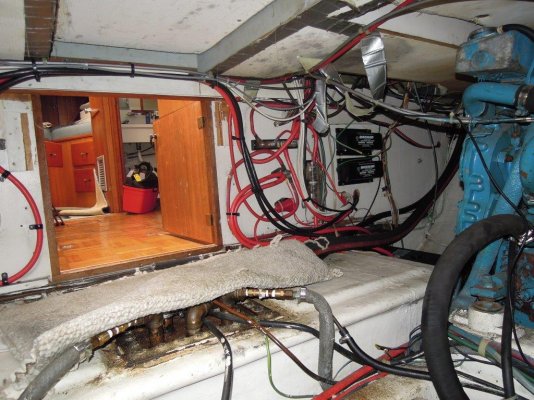Bilgewater
Senior Member
- Joined
- Jun 20, 2011
- Messages
- 276
- Location
- USA
- Vessel Name
- Sunset Lady
- Vessel Make
- 1975 Chris Craft 35 Aft Cabin
I installed a Seabuilt tank access system on my 36 trawler last week. As often happens, a 4 hour job turned into 4 days. I cut an access panel in the deck of the galley below the steps from the salon. Then I used a jig saw and cut an 8” opening in the top of the tank. Unfortunately, I ran into a stringer. I had to move the hole about 4” forward. I then cut a crescent shaped piece from the original cut-out to epoxy in place over the stringer. When that was finished, I discovered that the thickness of the tank (fiberglass, plywood, fiberglass) was equal to the length of the studs that hold the cover plate. I had to cut a ¾ inch rabbet around the rim of the opening to make everything work. With a vibrating cutting tool in one hand, and a shop vac nozzle in the other, I cut out short segments, then undercut the plywood to take the chunks out in one piece. I wanted to keep as much debris out of the tank as possible. When I made the first cut, I was surprised to discover the tank was full, 250 gallons of 3 year old diesel. I hope that after a thorough polishing, it will still be usable. After smoothing the rabbet as much as possible with a chisel, I spread some thickened epoxy around it. I then covered the cover plate with plastic, and pressed it in place to make a smooth mating surface for the seals. After the epoxy set, I used the cover plate as a template and drilled holes for the mounting studs, again using the shop vac to catch the debris. It was a simple matter to install the hinged bottom piece with the studs and gasket, then add the top gasket and cover plate. The Seabuilt website shows the process quite clearly. They also have great customer service. I had ordered an aluminum kit by phone. Within an hour, they called back to apologize that they were out of stock of that kit, but would I accept a stainless steel kit at the same price? Wow, twist my arm!!!!




